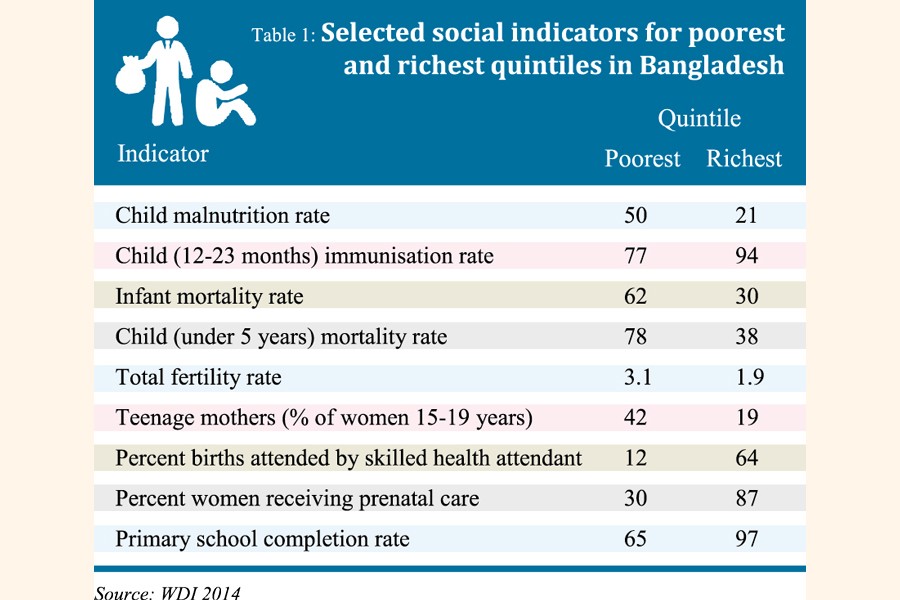
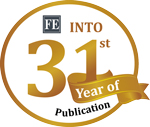 As the 170 million people of Bangladesh wake up every morning to face another day, they do so under very different circumstances. Some live in comfortable homes, have more than enough to eat, are well-clothed and healthy, and have a reasonable degree of financial security. On the other hand, millions of others have little or no shelter and inadequate food supply, have poor health and no education. Their prospect of a better life is uncertain. The fact remains that disparities regarding the basic needs of life across different population groups in the country are wide and, unfortunately, these are rising over time. Furthermore, the worst part is the fact that there are millions of poor people living along with plenty of millionaires who enjoy lavish living in Bangladesh.
As the 170 million people of Bangladesh wake up every morning to face another day, they do so under very different circumstances. Some live in comfortable homes, have more than enough to eat, are well-clothed and healthy, and have a reasonable degree of financial security. On the other hand, millions of others have little or no shelter and inadequate food supply, have poor health and no education. Their prospect of a better life is uncertain. The fact remains that disparities regarding the basic needs of life across different population groups in the country are wide and, unfortunately, these are rising over time. Furthermore, the worst part is the fact that there are millions of poor people living along with plenty of millionaires who enjoy lavish living in Bangladesh.
Over the last fifty-two years since independence, Bangladesh has done fairly well in reducing poverty compared with its South Asian neighbours and other developing countries. Yet there are nearly 31 million people in this country who struggle every day for survival. Still, there are many more millions living at the margin of poverty who struggle relentlessly for remaining above the poverty threshold. In spite of rapid growth and development, the number of people living in poverty and in the low-income brackets at risk of poverty remains high.
Key dimensions of inequality: In a country like Bangladesh, high inequalities tend to hamper economic growth and undermine both socioeconomic equality and social stability. Since inequalities have cumulative economic, social and political effects, each of these contributing factors requires separate and concerted attention.
Economic inequalities are corrosive to any society. It makes poverty reduction harder, hurts progress and development, and drives conflict and violence. Reversing economic inequalities presents a significant challenge, but there are multiple ways to move forward in reducing inequalities. The new and emerging face of inequality requires, more than ever before, active and comprehensive combination of social and growth-enhancing policies that target the bottom quintiles of the income distribution in any country. The key is also to adopt a more comprehensive social policy.
For example, successful conditional cash- transfer programmes must be accompanied by other well-targeted social programmes that can ensure local provision of good-quality essential services and other public goods e.g. roads, electricity, drinking water, sanitation, transport, access to information etc. Building an infrastructure for collecting data is another important part of understanding and addressing local inequality. Efforts to promote open use of data that is extensive, detailed, and periodically updated are an important part of this job.
Drivers of exclusion and inequality: A number of drivers usually operate to deepen inequality in a country. Inequality can usually be traced back to the historical pattern of socioeconomic structure that has evolved over time, such as an unequal distribution of assets--land, water, physical capital--local resources that underlie social power structure e.g. concentration of agricultural land in the hands of village elites and powerful people, the restructuring of social relationships e.g. redistribution of land/asset ownership resulting from land reforms and civic unrest and policies that disempower the poor and excluded groups in society e.g. land acquisition resulting in reduced access to common property resources and other natural assets for the poor and disadvantaged communities.
In addition, the reality is that there exist unequal access to education (affecting productivity and ability to earn income), health (impacting on the ability to participate in income earning and other activities), infrastructure services (affecting the ability to participate in the market), financial services (impacting on the access to credit and ability to invest), and labour market (influencing access to decent jobs). Similarly, disparities in informal-sector employment and migration and other inclusive development requirements (impacting participation, legitimacy and accountability) all lead to income and non-income disparities between those who are included and those marginalised and/or excluded.
Inequality perspectives in Bangladesh: The concern with equity has emerged strongly as an issue in economic development--and such inequalities are not merely about disparities of outcomes, it is also about disparities in opportunities in terms of age, sex, disability, race, ethnicity, origin, religion and economic or other status. Furthermore, in a country like Bangladesh where disparities in opportunities are so evident in every sphere of life, focus only on economic inequalities provides a partial picture of the status and policy agenda of inequality.
Income inequality in Bangladesh has always been a major policy issue. The Gini coefficient of income distribution (a measure of inequality) in Bangladesh had a value of 0.499 in 2022. And the country has experienced sharp increases in income inequality especially since the early 1990s as the income Gini was 0.271 in 1991. The gravity of the problem of growing income inequality becomes more complex if differentials in wealth accumulation are also taken into account.
The persistence of growing income inequalities also has serious implications on wealth accumulation. In Bangladesh, the number of poor at $3.10 a day (2011 PPP) is more than 86 million who can hardly save for wealth accumulation compared with the richer groups who hold significant shares of national wealth and continue to accumulate more over time. Thus future levels of inequality are likely to be much worse if existing wealth ownership and prospects of future wealth accumulation are taken into account.
The 2022 Social Progress Index, which measures country performance on a wide range of social and environmental performance, puts Bangladesh in Tier 4 as a 'lower middle social progress' country with a rank of 119 across 169 countries. Bangladesh is also identified as one of the countries where largest improvements in the Social Progress Index have taken place. This improvement suggests that Bangladesh, with a relatively low level of social progress, can improve more rapidly since it both has more opportunities for improvement and can draw on lessons from success cases in other countries.
There is also a significant correlation between income inequality and (low) quality of institutions. In theory, weak institutions may be conducive to income inequality. For example, where the poor are not given the protection of an independent judicial system, their ability to extract rents is inferior to that of the rich. It is also suggested that high income inequality allows the rich to wield stronger political influence, thereby subverting institutions. Indeed, global evidence shows that income inequality and poor institutional quality reinforce each other.
 Thus, institutional reforms could be good instruments to reduce inequality; but political factors are likely to prevent such reforms in a country like Bangladesh.
Thus, institutional reforms could be good instruments to reduce inequality; but political factors are likely to prevent such reforms in a country like Bangladesh.
For Bangladesh, three critical challenges can be identified for addressing inequalities:
Measurement Challenge: Only a few of the multidimensional indicators can currently be measured in a rigorous and regular manner in Bangladesh. The government and the civil society must therefore take the measurement issue further with flexibility in data sources to provide comprehensive and credible estimates on various dimensions of inequality.
Aggregation Challenge: The inequalities are observed and measured across various dimensions. We need to devise a conceptual model that would allow aggregation to explore complementarities and synergies across different dimensions for carrying out the required inequality- reduction policy agenda forward.
Localisation Challenge: Much of the efforts on implementation of the inequality- reduction agenda will have to take place at the local level, and this will require local data to track performance. The local-level institutions, including NGO-MFIs and civil-society think-tanks, will have to be used extensively by district, city, and upazila/union-level local-government institutions to provide practical tools for localisation of inequality-reduction agenda.
Bangladesh has achieved notable success in steadily accelerating economic growth, along with unprecedented progress in improving key social indicators. One may, however, note that poverty in Bangladesh is measured by consumption-instead of income--as the indicator of current living standard, as consumption is considered a better measure of 'permanent income' than income itself. This, however, does not recognise the fact that the poor are often forced to sustain consumption by liquidating assets or by borrowing.
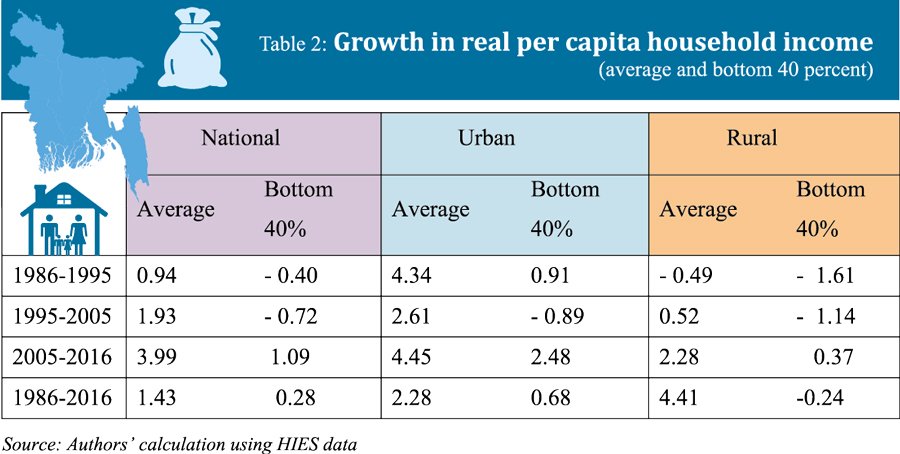 The household income and expenditure survey (HIES) data show that income inequality is much higher than consumption inequality, and the ratio of income inequality to consumption inequality is rising over time. This means that, given similar poverty thresholds for income and consumption, income-poverty reduction would be slower than the reduction in consumption poverty. It is well-known that social indicators vary significantly across different income groups in the same country. Table 1 shows the glaring social inequalities that exist between the poorest and the richest quintiles of Bangladesh population.
The household income and expenditure survey (HIES) data show that income inequality is much higher than consumption inequality, and the ratio of income inequality to consumption inequality is rising over time. This means that, given similar poverty thresholds for income and consumption, income-poverty reduction would be slower than the reduction in consumption poverty. It is well-known that social indicators vary significantly across different income groups in the same country. Table 1 shows the glaring social inequalities that exist between the poorest and the richest quintiles of Bangladesh population.
The above shows that inequalities in education, health and other basic services are significantly related to income and wealth. Data available from different Bangladesh Bureau of Statistics (BBS) surveys show that the percentage of malnourished children under 5 in 2011 is about 50 percent in the poorest quintile whereas it is 20 per cent for the richest quintile. Only about 12 per cent of mothers in the poorest quintile in 2014 are lucky enough to have the opportunity to be attended by skilled health personnel during childbirth while it is around 64 per cent for the richest quintile.
Bangladesh has already achieved gender parity in primary and secondary education at the national level. This positive development has occurred due to some specific public interventions focusing girl students, such as stipends and exemption of tuition fees for girls in rural areas, and the stipend scheme for girls at the secondary level. This has contributed to promoting the objectives of ensuring gender equality and empowerment of women. There has been steady improvement in the social and political empowerment scenario of women in Bangladesh. The government has adopted the National Policy for Women's Development 2011 and a series of programmes for empowerment of women.
The issue of inequality is thus multidimensional and linked to most other dimensions of development. An equal society can only be ensured if all individuals and social groups can use their productive abilities to the maximum extent for enjoying greater social welfare and inclusive development. In reality, while much progress has been made towards reducing gender inequality, inequality in income, wealth, and employment still remains very high.
To achieve universal realisation of equality and empowerment, it is critical to address key areas of inequality, in particular, inequalities in opportunities, discrimination in law and in practice, women and men's unequal opportunities in the labour market, unequal division of unpaid care and domestic work, poor's limited control over assets and property, and their unequal participation in private and public decision-making and businesses.
Rising inequalities: A divided humanity: Rising inequalities have always been considered a major policy issue in Bangladesh. Is income inequality rising in Bangladesh? The Gini coefficient of income distribution stood at 0.499 nationally in 2022, which constitutes 0.446 in rural areas and 0.539 in urban areas. The trend of income inequality since 1963 shows that national Gini has risen from 0.36 to 0.499-an increase by more than 39 per cent-while rural Gini increased by nearly 38 per cent and urban Gini by 46 per cent over the same period. These figures suggest that the country has experienced increases in the Gini coefficient over the period of last half a century but the rate has accelerated especially since the 1990s.
There is a growing consensus that the best indicator for looking at the worst form of income inequality is the Palma ratio, which effectively focuses on extremes of inequality-the ratio of incomes at the very top to those at the bottom. In Bangladesh, it is changes in these extremes that are most noticeable, while the share of income in the middle is relatively stable. The Palma ratio at the national level had consistently increased from 1.68 in 1963-64 to 2.93 in 2016 in Bangladesh. In urban areas, it rose from 2.00 to 2.96 while, in rural areas, it grew from 1.38 to 2.51 over the same period (Figure 1). The policy implication is that Bangladesh should focus on its 'extreme' inequalities, that is, inequalities that do most harm to inclusive and sustainable economic development and undermine social and political stability.
In the case of income, the above suggests that policies should be to progressively achieve and sustain income growth of the bottom 40 per cent of the population at a rate higher than the national average. The national average income growth and the income growth of the bottom 40 per cent of the population since the 1980s in Bangladesh are given in Table 2. The average per-capita household income (at 2010 constant prices) over the 1986-2016 period grew at 1.43 per cent while the same for the bottom 40 per cent grew by only 0.28 per cent. The situation is worse in the rural areas as, while the average per-capita income grew by a healthy 4.41 per cent, the income of the bottom 40 per cent actually declined by 0.24 per cent. As can be seen from the table, per-capita income of the bottom 40 per cent--both nationally and in the rural areas--started showing positive growth only since 2005.
Along with income, one can observe growing geographical, gender-based and group-based inequalities in many other dimensions in the country. In reality, income distribution in Bangladesh is becoming more asymmetric, indicating a growing income gap between the rich and the poor. Another shift is the changing geographical poverty in Bangladesh. Educational facilities are observed asymmetric between cities and rural areas which do not take into account the need of the remote areas. The differential quality of education is a major challenge at all tiers of the education system.
Inequality in Bangladesh is not a new phenomenon--yet it can be fatal. If left unchecked, it can undermine the very foundation of development and the country's social fabric. Over the last decades, Bangladesh has witnessed impressive average gains against multiple indicators of material prosperity. For instance, GDP per capita has more than tripled in real terms, and average life expectancy has risen over 73 years.
However, this is only part of the picture. Although Bangladesh is richer than ever before, around 31 million people still live in poverty. The richest 5.0 per cent of the households get nearly 30 per cent of the total income while the bottom 5.0 per cent get only 0.22 per cent. Despite overall declines in maternal mortality, women in rural areas are still up to three times more likely to die while giving birth than women living in urban centres. Social protection has been extended, yet persons with disabilities are up to five times more likely than average to incur catastrophic health expenditures. Women are participating more in the workforce, but continue to be disproportionately represented in vulnerable employment. Humanity remains deeply divided in Bangladesh.
Nor are recent trends encouraging. Over the last two decades, income inequality has been rising in Bangladesh. As a result, the country's population lives in a society that is more unequal today than after independence. The income gap has deepened - and, with it, the difference in quality of life between the rich and the poor - despite the immense progress made through impressive growth performance. Economic progress in the country has not alleviated disparities, rather exacerbated them. Overall, the Bangladesh society is more unequal today than at any point in time after independence!
Broadly, inequality in a society has many dimensions such as economic (income and wealth) inequality, gender inequality, educational inequality, racial and ethnic inequality, health and nutrition inequality, demographic inequality, political inequality, and so on. There exist complex interactions among different forms of inequality, and the multidimensional drivers of inequality call for a holistic approach to mitigate and overcome the challenges.
Challenges and way forward: Designing the right policy framework for addressing inequalities is the biggest challenging area to work in Bangladesh, like in other developing countries. Inequalities of outcomes and opportunities are highly inter-dependent. Without equal opportunities, systemic patterns of discrimination and exclusion prevent the poor and disadvantaged communities from accessing economic, political and social resources, resulting in inequality traps - and the persistence of inequality across generations. Equal opportunities can level the playing field so that the circumstances of birth, such as race, gender, rural or urban location, do not adversely influence an individual's chances to get ahead in life.
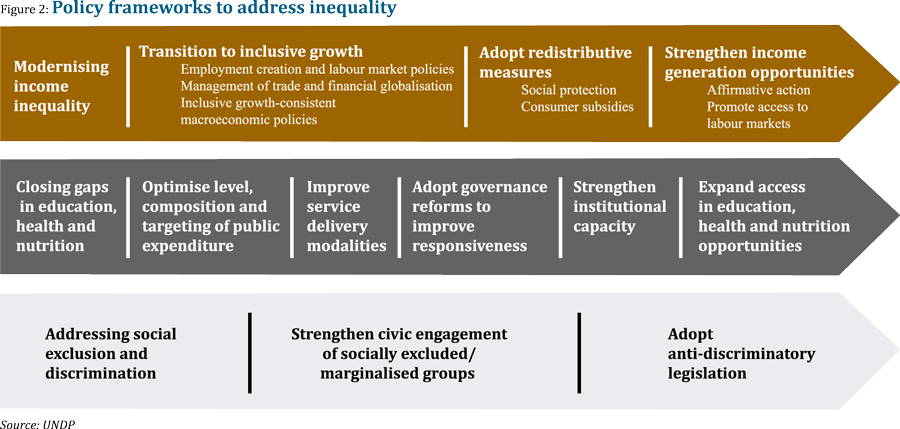 Since inequality of outcomes and that of opportunities are interlinked and mutually reinforcing, a comprehensive policy framework to reduce inequality needs to address both. The mix of policies and how they are sequenced to address inequalities are context-dependent and specific to the needs and requirements of each community. Nevertheless, priority should be given to deeper and more persistent gaps. For example, rapid urbanisation might lead to declines in income inequality, but widening gaps in education or health might need to be prioritised.
Since inequality of outcomes and that of opportunities are interlinked and mutually reinforcing, a comprehensive policy framework to reduce inequality needs to address both. The mix of policies and how they are sequenced to address inequalities are context-dependent and specific to the needs and requirements of each community. Nevertheless, priority should be given to deeper and more persistent gaps. For example, rapid urbanisation might lead to declines in income inequality, but widening gaps in education or health might need to be prioritised.
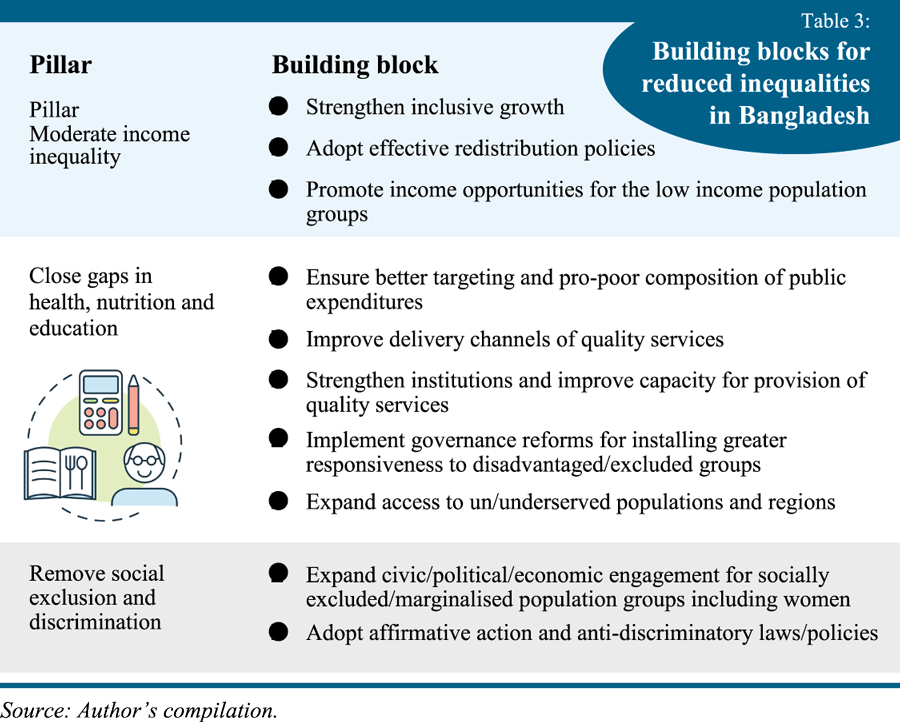 A comprehensive policy framework is necessary to help policymakers better navigate the complexities and challenges of forming appropriate policies to address inequality based on three related pillars (a) moderating income inequality (b) closing gaps in health, nutrition and education and (c) addressing social exclusion by promoting agency, combating discrimination and transforming inequality-reproducing cultural norms.
A comprehensive policy framework is necessary to help policymakers better navigate the complexities and challenges of forming appropriate policies to address inequality based on three related pillars (a) moderating income inequality (b) closing gaps in health, nutrition and education and (c) addressing social exclusion by promoting agency, combating discrimination and transforming inequality-reproducing cultural norms.
These pillars may be built around several building blocks, as shown in table 3. Inclusive growth can be thought of as a strategy to increase the extent to which the economy's top-line performance is translated into the bottom-line results that society is seeking i.e. broad-based expansion of economic opportunity and prosperity. However, inclusive growth is more than that. An economy is not a business and there is a feedback loop between the bottom- and top-lines (growth and equity) in an economy. This feedback loop can run in either a positive or a negative direction. The World Economic Forum 2017 Report named 'The Inclusive Growth and Development Report' provides the ecosystem of inclusive growth based on seven pillars (Figure 2).
'Leaving no one behind (LNOB)' agenda is an underlying principle for reducing inequalities. Its aim is to ensure that development has positive impacts on the poorest and most marginalised members of society. This requires localisation of inequality- reduction efforts and to 'put the last first' to ensure that areas of relative deprivation are targeted when implementing these efforts at the local level.
Another critical role of civil society is to ensure that the government is held accountable. Accountability is typically based on three elements: responsibility, answerability and enforceability. Responsibility entails that those in positions of authority have clearly defined duties and performance standards, which enable a transparent and objective assessment of their behaviour. Answerability demands that public officials and institutions present logical and articulate justifications for their actions and decisions to those affected, such as the general public, voters and other institutions.
Enforceability requires public institutions to implement mechanisms that measure the degree to which government officials and institutions abide by established standards, and that enforce sanctions on officials who do not comply and, when needed, ensure that the proper corrective and remedial action is carried out. These three elements of accountability are not mutually exclusive, but interlinked. It is thus paramount that the roles and responsibilities of the government are clearly defined, particularly in terms of the answerability and enforceability dimensions.
Inequality reduction agenda: Much of the economic inequality in Bangladesh is associated with 'rent-seeking'. And such inequality undermines economic efficiency. However, the worse form of inequality that is widespread in the country is inequality of opportunities, which are both the cause and consequence of inequality of outcomes.
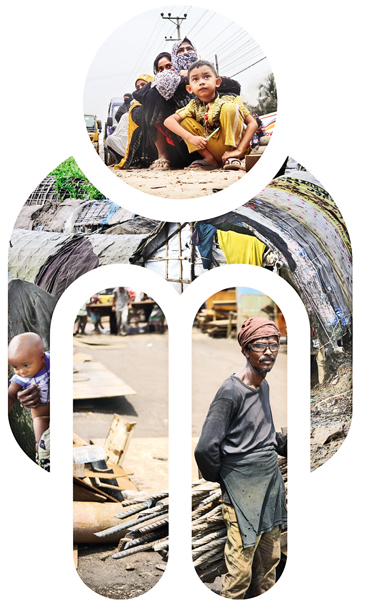 Reduced inequalities have both economic and social benefits. It strengthens people's perception on fair society, improves social cohesion and mobility, and boosts employment and education with beneficial effects on human capital and development. Inequalities in society are partly the result of economic forces, but these are widely affected by public policy choices, such as taxation, level of minimum wage, and investments in social sectors e.g. health care and education.
Reduced inequalities have both economic and social benefits. It strengthens people's perception on fair society, improves social cohesion and mobility, and boosts employment and education with beneficial effects on human capital and development. Inequalities in society are partly the result of economic forces, but these are widely affected by public policy choices, such as taxation, level of minimum wage, and investments in social sectors e.g. health care and education.
Similar to the analysis of poverty and poverty reduction expanding from a uni-dimensional (e.g. income) focus to multi-dimensional deprivations, the case of inequality has also evolved around many dimensions. Indeed, inequalities in wealth exceed those in income. Especially in countries without adequate public health systems, a Palma ratio of health status would show even greater inequalities than a Palma ratio for income. A Palma ratio based on exposures to environmental hazards is also likely to demonstrate a similar trend. One of the worst forms of inequality in Bangladesh relates to inequality of opportunities, as reflected in a lack of socioeconomic mobility, forcing those at the bottom of the socioeconomic pyramid unable to move upwards. Inequality of income tends to be associated with less economic mobility and fewer opportunities across generations.
Since different dimensions of inequality are related, focusing on one dimension at a time may underestimate the true magnitude of societal inequalities and provide an inadequate basis for policy. For example, health inequality is both a cause and a consequence of income inequality. Inequalities in education are a primary determinant of inequalities in income and opportunity.The policy implications of the current status of inequality is that Bangladesh should focus on 'extreme' inequalities, that is, inequalities that do most harm to inclusive and sustainable development and undermine social and political stability.
There are many dimensions to inequality in the country-some with worse effects than others-and there are many ways to measure these inequalities. However, one thing is clear: for achieving inclusive and sustained development, Bangladesh cannot ignore extreme inequalities. The World Bank study on Voices of the Poor highlights that the poor suffer not just from a lack of income but from insecurity and a lack of voice.
The spatial dimension of inequality has also attracted considerable policy interest, since regional disparities in economic activity, incomes and social indicators foster overall income inequality. Despite obvious importance of regional inequality, few studies exist in Bangladesh which analyse its causes systematically.
One issue that has received increasing attention over the years is the role of decentralisation in regional inequalities. The major argument is that decentralisation enhances public- sector efficiency but can weaken inter-jurisdictional redistribution, causing a rise in regional inequality. Thus, a conflict between efficiency and redistribution might arise from decentralisation. Nonetheless, decentralisation and its effects are important for Bangladesh since it is an important element of the country's development strategy. The practical evidence on the redistributive consequences of decentralisation is rather mixed.
To be effective, the decentralisation initiatives taking place in Bangladesh should be supported by suitable additional redistributive instruments depending on whether to redistribute between individuals or regions. Regional inequalities contribute to interpersonal inequalities so it might be more efficient to redistribute between individuals using tax-transfer schemes instead of redistributing between regions.
Another study finds that interregional transfers increase regional inequalities if people are mobile, so interpersonal transfers seem to be more suitable to achieve a more equal income distribution. It must be emphasised that inequalities of wealth and income have a significant impact for the achievement of economic, political and human development. A high level of economic inequality undermines the country's growth potential, retards the development of social capital, and encourages corruption, even at the local level.
Since independence, overall economic inequality in Bangladesh has become pervasive, but it is avoidable. The rising inequality has emerged not only because of differences in what people inherited and received, but, more fundamentally, due to big inequalities in accessing opportunities and sharing outcomes. This makes economic inequalities an issue that calls for insights into the functional dynamics of deriving economic and social opportunities and how the political process shapes and perpetuates the country's structural features of unequal privilege and neglect of poor and disadvantaged communities.
Most of Bangladesh's poor live in rural areas and are engaged in farming. This shows that, for reducing income inequality, agricultural development is essential to directly increase the incomes of the poor who farm, but also for releasing labour and capital that can be used in non-farm enterprises and for stimulating the demand for non-agricultural goods.
This emphasises the positive linkages between agricultural development and non-farm activity growth--local 'trickle-down' from improving farm productivity. Thus policies that encourage investment in the rural, non-farm sector may be the best means of reducing rural poverty and inequality. However, it is unclear which policies lead to increased rural non-farm investments in the absence of a dynamic agriculture, especially in the presence of credit constraints, labour rigidities and inadequate schooling that is emphasised in the relationship between the non-farm sector and rural inequality.
But even in rural areas, the treatment of non-farm activity as a single homogenous good is not appropriate. Rural non-farm activity ranges from household and village production on a very small scale producing simple, low-quality products on the one hand, to CMSMEs on the other, sometimes using imported technology and producing modern high-quality products. The high-quality products sector that plays a central role in this framework combines two separate elements: production of exportable goods that can be traded on a larger market and production of non-tradable goods and services.
In the context of inequality reduction in Bangladesh, it is important to consider separately the non-tradable and tradable non-farm sectors within a 'general-equilibrium' framework. While the non-tradable sector is driven by local- demand conditions and thus is positively influenced by growth in agricultural productivity, the tradable non-farm sector enters areas with relatively low wages and thus is negatively influenced by growth in agricultural productivity. As a consequence, non-farm growth tends to reduce inter-village rural inequality induced by agricultural technological change.
Moreover, the CMSMEs tend to employ low-skilled labour. Thus, the growth in such employment increases the incomes of the poor and, given that the landed (better-off) households are net hirers of agricultural labour, this decreases intra-village inequality. By contrast, particularly in the presence of mobile capital which dampens regional variation in wages, agricultural- productivity growth tends to increase inter-village inequality.
These mechanisms can only work in the presence of well-functioning labour and goods markets and an external source of mobile capital. Thus, it is important to reduce the barriers to the movement of capital along with investments in agricultural technology. Bangladesh has a long history of public investments in agricultural innovation. But, clearly more needs to done to better understand the process of rural industrialisation so that the most appropriate policies can be put in place.
For Bangladesh, the risk of increasing inequality associated with active participation in the global economy is greater, especially because of inherent institutional weaknesses associated with being a relatively low- income country. It is true that globalisation - that is the trend of increasing integration of economies in terms not only of goods and services, but of ideas, information and technology - has tremendous potential benefits for a country such as Bangladesh. The challenge is to realise the potential benefits without undertaking huge offsetting costs.
From a policy perspective, not all inequalities are 'bad' for Bangladesh. Some inequalities represent the outcomes of differences across individuals in ambition, motivation and willingness to work. The 'constructive' inequalities provide incentives for mobility and reward higher productivity. Increases in constructive inequalities may simply reflect faster growth in income for the rich than the poor - but with all sharing in some growth.
But, of course, some inequalities are 'destructive' when these reflect deep and persistent differences across individuals or groups in access to productive assets--including not only land but, most importantly, education and skills. Obviously, destructive inequalities undermine economic growth and efficiency, by reducing the incentives for individuals to work, save, innovate and invest. These may often create a backlash against market reforms and institutions that in the long term are the critical ingredients of reducing inequalities and fostering shared development.
In Bangladesh, changes in the structure of output and income are one of the major sources of changes in inequality. Among different components of income, wages are generally the most equalising component, but its share in both rural and urban personal income has been declining steadily, contributing to rise in inequality. Since the 1980s, the share of wages in total personal income has fallen by more than a third. This can at least be temporarily reversed by pursuing policies for broad-based nonfarm growth and expanding employment-intensive growth. Over the medium term, this would be a powerful instrument of containing inequality in Bangladesh for which investments in both physical infrastructure and human capital are necessary pre-requisites.
As the HIES data indicate, there exist several sources of income inequality in Bangladesh: income from nonfarm enterprises, land and non-land assets, and remittances from abroad. Income from nonfarm enterprises largely represents return to owned enterprises and hence is the return to wealth.
International remittances are also concentrated to relatively better-off households as overseas migration entails high costs beyond the reach of most poor households. Thus, the increase in the relative importance of incomes from nonfarm enterprises and remittances are both highly inequalising as the incomes accrue mostly to higher- income groups.
Obviously, curbing growth in these components is a self-defeating policy that could lead to reduced income growth. One way to address the issue is to tax components of these incomes in a way that do not reduce incentives. The other available instrument is public transfer to the poor. Prospects for a large increase in transfer, which is large enough to make a difference in the change in income distribution, is, however, impractical for a number of reasons, including limited availability of public resources and inevitable leakages in the distribution system.
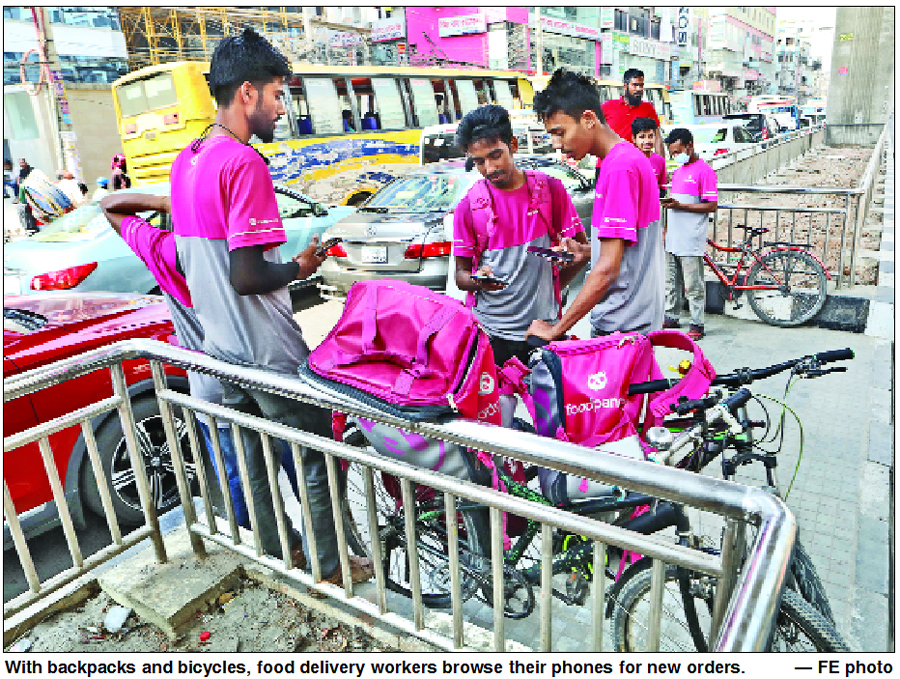 One must also recognise that HIES data miss out much of the incomes at very high levels, partly because these households are less easily accessible and their true incomes are difficult to capture by the enumerators. For example, one of the most disequalising components of income which has increased as a proportion of total income rapidly is capital gains from exploding real estate and land value. It is unlikely that any significant part of it is captured in the HIESs.
One must also recognise that HIES data miss out much of the incomes at very high levels, partly because these households are less easily accessible and their true incomes are difficult to capture by the enumerators. For example, one of the most disequalising components of income which has increased as a proportion of total income rapidly is capital gains from exploding real estate and land value. It is unlikely that any significant part of it is captured in the HIESs.
Another large component of such income consists of what is often referred to as 'black money', incomes shared between those in a position to hand out scarce entitlements and their recipients. Many of the past policies have led to the emergence of a manufacturing and trade regime that certainly means a much greater flight of earnings and capital which, if captured, would reveal extraordinarily unequal distribution.
In reality, a decent system of taxation together with provision of social protection to the poor could support a process of inequality-averse growth. But one must also remember that the nature of state power in a country like Bangladesh seeks for avenues of rent appropriation. These are used in distributing contract for public procurement and favours to trade and industry to overcome 'invisible' controls. As a result, investments remain less efficient as the choice is dictated by a distorted market and by those who have best access to state power. Recognising the fact that the implementation of equitable policies will face a number of hurdles:
Key issues for Bangladesh: No doubt, rising inequality is a big burden for Bangladesh and has serious implications for ensuring secure, sustainable lives and livelihoods for all. Indeed, there are many pressing concerns for the country, but we must not lose sight of the challenges and obstacles created by inequality and discrimination. 'When inequality creates discriminatory outcomes, it becomes a human-rights issue'. In Bangladesh, rising vertical inequality concentrating greater amounts of wealth among a small group of economic and social elites coupled with horizontal inequalities that marginalise specific communities, while perpetuating cycles of existing privilege, undoubtedly create discriminatory outcomes.
One must also recognise that most inequalities are rooted in issues of social, legal and economic inequality that exists in the country. Inequality is intrinsically linked to overall socioeconomic and structural features in the country since the poor and the marginalised are often the most vulnerable to social and economic costs of unsustainable production and consumption patterns and a changing climate. By reducing inequality, these vulnerabilities can also be reduced. Inequality, therefore, must be faced in an integrated manner, and at the global level, e.g. climate change, as well.
No doubt, many tools are available for reducing inequality. Universal social- protection policy, including healthcare and social (micro) insurance, can ensure that all people have access to basic services and protections-- and fair, effective, progressive tax systems can help produce a more equal distribution of wealth. The critical challenge is to address social and cultural inequalities that are deeply entrenched and woven into the fabric of society. Universal social protection, while necessary and essential in Bangladesh, will not rectify the long history of discrimination, and hence should be an integral component of wider efforts.
As Bangladesh moves forward in reducing inequalities, indicators and methodology for evaluating progress must consider both vertical and horizontal inequalities that create and perpetuate various cycles of exclusion.
A key concern for Bangladesh is to translate the directional model for inclusive development into a pragmatic action agenda for implementation. For the medium term, Bangladesh needs to create effective economic institutions and proper policy incentives, while also pursuing sound macroeconomic policies and efficiency-enhancing reforms over time. Bangladesh needs to have success in building a robust middle class and reducing extreme poverty and social exclusion and marginalisation for creating a more equitable society.
The above discussion illustrates the patterns, dynamics and the challenges of inequalities over the last fifty years in Bangladesh. However, these are not mutually exclusive, neither these should be treated as causes or symptoms. There are many other issues of social, cultural and political processes which are also important ingredients of the processes and the outcomes, reinforcing the historical aspects and inter-generational dimensions of inequalities.
The discussion highlights that probably the most important dimension of the country's development process is acute inequalities and the trend towards increasing inequalities covering most dimensions (economic as well as non-economic) of development. It is seen that many people still have inadequate access to basic services to benefit from the current development process which shows the state's unethical and unfair biases in favour of the rich and the elite.
The uneven development process has also been fueled by democratic deficit in Bangladesh under the powerful neoliberal regimes. The proponents of neoliberalism hold that inequity in development is the outcome of inadequate functioning of the market mechanism and prescribe that creating 'market-friendly' social structure and economic institutions which are self-regulating and can respond to economic regulations and incentives will generate a process of inclusive and equitable development in Bangladesh. However, the development reality in Bangladesh points to the tendency towards inequality in every sphere of life, and that the structural process itself compels the state to remain strongly biased towards the rich and powerful elite. No doubt, the 'elite capture' of the state has contributed much towards widening the democratic deficits in Bangladesh.
Furthermore, the development process in Bangladesh portrays a relentless struggle between the masses and the elite for better policies in fulfilling the state responsibilities of basic rights, such as removal of socioeconomic exclusion and marginalisation of disadvantaged communities, universal social security and gender equality, eradication of poverty and hunger, right to food and nutrition, access to quality and affordable education and healthcare, right to sustained and decent employment and livelihoods, and ensuring environmental sustainability and other democratic and basic needs. No doubt, Bangladesh has achieved significant progress in many respects e.g. public distribution of food at low prices, pension to the elderly, distressed women and disabled peoples, social protection and cash transfers to deprived sections of society including the poor and disadvantaged women, dalits, minorities and indigenous peoples. But, it has yet to fulfill the basic principles of justice and democracy such that no one is left behind.
In short, equality and justice along with equal opportunities for all, as ingrained in the concept of inclusive development, needs to be the cornerstone of equitable and sustainable development in Bangladesh. For the purpose, the state must guarantee equitable access to land and other natural resources and socioeconomic opportunities that are vital for sustaining the people's livelihoods and ensuring the inclusion of the disadvantaged and left-behind communities. Deep and equitable reforms are needed to overhaul the legal, institutional and structural arrangements in the country. Besides, it is important that the rights of women and other disadvantaged communities are ensured. The key is to ensure fair and equitable representation for all in political, state, economic and social institutions by abolishing all forms of discrimination in society. While not undermining the critical importance of other dimensions, including health, education, social inclusion and protection for the disadvantaged communities, in the process of reducing inequalities, the country's labour market and its dynamics is probably the critical entry point for strengthening the process of inclusive development in Bangladesh.
Mustafa K. Mujeri is Executive Director, Institute for Inclusive Finance and Development (InM).
mujeri48@gmail.com
© 2025 - All Rights with The Financial Express
